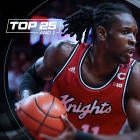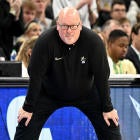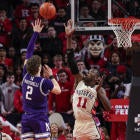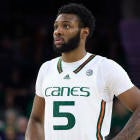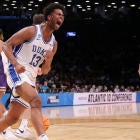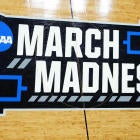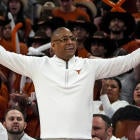If not for a closed scrimmage against Colorado, Doug McDermott may have never built a story into a saga in Omaha.
If all had gone to plan, McDermott would be a junior right now and just another really fine player amid a really fine college basketball season. Instead, he’s a senior on the verge of the historic; is the out-of-control favorite to sweep player-of-the-year awards; and is five months away from becoming the second Creighton player since 1971 selected in the first round of the NBA Draft, where he's slotted as a lottery pick.
If not for that closed scrimmage against Colorado, Doug McDermott was going to redshirt. Greg McDermott, Doug's coach and dad, saw how thin Doug was, and remembered how Greg himself could have benefited from a redshirt year when he was Doug’s age, playing at Northern Iowa in the mid-1980s. So Creighton’s getting ready to play this exhibition against Colorado, and turns out one guy on the team’s sick. Plus, Ethan Wragge was injured with a bad foot. Needing bodies, Greg allowed Doug to play. He scored 16 points and snagged seven rebounds against a major-conference team that would go on to win 24 games that season.
That performance, seen by maybe 50 people total, put McDermott on a course to start as a freshman, and eventually carve out one of the greatest careers in college basketball history. Thanks to a dash of injury and illness back in October 2010, McDermott’s now on the precipice of passing the supreme 3,000-point plateau as one of college basketball's best seniors in a generation.
Historic numbers
So here we sit, mid-winter of 2014, and Doug McDermott is perched at 2,741 points, which places him 18th in history. He’s on pace to crack 3,000 at the Big East tournament, and would become just the eighth player in the history of Division I men’s basketball to achieve the feat.
Barring injury or an extremely unlikely long spell of bad play, McDermott will be the first player in 30 years to make the AP All-American First Team three straight times. Other guys who’ve done that: Patrick Ewing, Wayman Tisdale, Bill Walton, Pete Maravich, Lew Alcindor, Ralph Sampson, David Thompson, Jerry Lucas, Oscar Robertson and Tom Gola. That’s the entirety of the list, every single name in the Naismith Hall of Fame. And McDermott will be joining their ranks.
As the games go on, he’s cruising past other legendary names of college basketball lore like Elgin Baylor, Shawn Respert, Jimmer Fredette, Calbert Cheaney, Steph Curry and David Robinson on the all-time scoring list. Last Tuesday against St. John's, he zipped past Byron Larkin, Daren Queenan and Hank Gathers in one game. Next up: J.J. Redick. Eventually Larry Bird, Allan Houston, Danny Manning and Robertson will be in his rear-view. I mean, this is preposterous.
Here’s the list of players with more than 3,000 points in D-I history. At his current average/pace (25.0 PPG), and with a conservative estimate of 13 more games for Creighton this season, McDermott will wind up tied at No. 5 on the all-time list after he removes his Creighton jersey for the final time.
|
Name
|
School
|
Years
|
Points
|
|
Pete Maravich
|
LSU
|
1967-70
|
3,667
|
|
Freeman Williams
|
Portland State
|
1974-78
|
3,249
|
|
Lionel Simmons
|
La Salle
|
1986-90
|
3,217
|
|
Alphonso Ford
|
Miss. Valley State
|
1989-93
|
3,165
|
|
Harry Kelly
|
Texas Southern
|
1979-83
|
3,066
|
|
Keydren Clark
|
St. Peter's
|
2002-07
|
3,058
|
|
Hersey Hawkins
|
Bradley
|
1984-88
|
3,008
|
“Probably since Christmas I’ve caught myself thinking about it more times than in the last three years, some of the things Doug and his teammates have achieved,” Greg said. “Every time he passes someone on the scoring list, it’s hard not to sit back and think how great that is.”
How great? This great.
-- With six rebounds in his next game, Feb. 7 vs. DePaul, McDermott will become the 10th player in NCAA history with more than 2,670 points and 1,000 rebounds.
-- He’s on the threshold of averaging better than 50 percent from the field, 40 percent from 3-point range and 90 percent from the foul line. Combine that with scoring more than 24 points per game, and he’s the first player to post such a stat line in college basketball since the 1990s. Seventy-three of his 131 games have seen him crack 20 points, and in 21 of those games he’s gone for more than 30.
-- Think he’s done this against mid-major competition? In 23 games against teams from major-conference programs, Creighton is 20-3, two of those losses coming in the NCAA tournament against Duke and North Carolina. In those 23 games since his sophomore season, McDermott has put up 25.6 points and 7.9 rebounds and Creighton has won 15 of them by double digits.
-- He has more 30-point games in his career (19) than all other Creighton players (17) in the program’s 700-plus games since 1991-92.
-- In winning the Big East Player of the Year, he would be the first player ever to obtain the honor in two conferences.
-- His 45.8-percent career clip from 3 is a school record.
-- Is averaging 25.0 points, 7.1 rebounds and shooting 43.9 percent from 3-point range this year. In the past 15 years, only Kevin Durant’s 2006-07 year at Texas can match/better that (25.8 PPG, 11.1 RPG, 40.4% on 3s).
And, oh, he’s been doing it as of late with a sprained joint in his left shoulder, which required cortisone shots before games. The recent injury caused him to miss his first practice ever -- due to dad and doctors’ mandate. Not that you'd know it. Whatever the limitations, McDermott has refused to slow down. The statistical markers have surprised even McDermott's father and coach.
“In some ways it’s really hard to believe because there’s just been so much growth and change in his game over the course of the past five or six years,” Greg said.
McDermott's style? 'It's not Jimmer-ish'
That off-foot fadeaway. That pure, square stroke from 21 feet juxtaposed against the quirky delivery off a spin move six feet from the tin. How the ball lands so softly on the rim. That touch; he’s got the knack. That deft, left-hand emergency option. Of McDermott’s 992 field goals in his career, 126 of them have been with his left hand and 436 have come using the glass. How does a player get his way to more than 3,000 points and not develop a reputation as a ball hog or me-first player?
“Doug always had the ability to be in the right place at the right time,” Greg said. “He’d find a way to get easy baskets, and they wondered how that could transfer from high school to college. And now NBA guys wonder how does that transfer to their game.”
 |
| Doug McDermott has a game made for any era. (USATSI) |
His mid-range game is now his favorite asset; that vulnerable 12-to-15-foot invisible crescent on the court that can be exposed against many college athletes/defenses. Though he started as a pick-and-pop player, McDermott’s never been a guy to crank 3 after 3. Creighton’s personnel is perfect for his game. Everyone is a willing passer, McDermott as much as anyone else.
“He’s known for his touch, and angles, but now he can break you down off the dribble and pull up off the dribble from 15 feet,” Wragge, now a senior, said. “Hearing night in, night out he’s passed David Robinson or Steph Curry, it’s crazy, because he came in here, unrecruited, and has fallen in place perfectly for him to be top-10 all time in scoring. It doesn’t seem like I’m out there playing with a guy that’s forcing up 20 shots per game.”
The team is filled with terrific shooters, like a true 3-point specialist in Wragge, which creates spacing and forces respect from the defense. That allows McDermott room to roam -- watch him without the ball; he’s as active as any player in the sport -- and he’s improved at reading screens. Creighton is tracking to be the most efficient points-per-possession group in more than a decade, leading the country in made 3-pointers (230), most assists per game (18.3) and the highest assist-to-turnover ratio (1.76).
“It’s a lot of our offense. It’s not Jimmer-ish, where I pull up from half-court and hit these crazy shots,” McDermott said of his gaudy career numbers. “It’s more within the flow of the offense. I think my teammates deserve just as much credit.”
He’d already be above 3,000 and threatening the No. 2 spot on the list above were it not for Greg keeping him out of the game in blowouts. Many times over the past three seasons have seen dad yank Doug when the game was no longer competitive, most recently evident in Creighton’s pair of 28-point wins over Butler and at Villanova, wherein the Bluejays set a Big East and program record with 21 3s.
“That’s what’s best for our team and best for Doug at this time,” Greg McDermott said. “If it doesn’t happen, I won’t have any regrets and I don’t think Doug will either. … It’s going by way too fast for all the seniors. It wouldn’t be fair or his team if I coached with [getting to 3,000] in mind.”
Growing with the game
Doug McDermott was born in Grand Forks, N.D, when Greg was an assistant at the University of North Dakota. Basketball was immediately a part of Doug’s life due to being a coach’s son, though by his own account he wasn’t really any good at the sport until midway through his high school years.
Greg took his first head coaching job at D-II Wayne State, in Nebraska, in 1994 when Doug was 2 years old. When Doug was in second grade, Greg moved on to coach North Dakota State in Fargo. The alma mater, Northern Iowa, came a year after that, and then eventually Iowa State, in 2006, when Doug was a freshman in high school. Iowa State was a huge deal. It was the biggest job of Greg’s life, and it was seen as a move that could alter the family’s future, plus would give Doug a chance to be at one place throughout his high school years.
Doug was 6-foot-1 as a freshman. He got to 6-4 as a sophomore. At that point he assumed he’d be a manager for his dad at Iowa State.
“That, or go to any random school and party,” he said. “I had such a different outlook.”
The first scholarship offer came from Albany, after he grew few inches heading into AAU circuit, before his junior year. He didn’t even think the school was serious. McDermott devoted as much time to being in the school’s ping pong club as he did basketball. He was also a recreational golfer.
“I played in the state tournament. Varsity. Took dead last at states,” he said wryly.
But as a junior at 6-7, still coming off the bench for Ames High School, he started taking car rides with Harrison Barnes, the No. 1 recruit in the country who’d go on to leave Iowa, play two years at North Carolina and is now with the Golden State Warriors. After team practice at the high school, Doug would drive himself and Harrison, who didn’t have a license, about 12 minutes away to Iowa State to play with the D-I fellas. Being coach’s kid, the ISU players didn’t pay Doug much attention. Harrison? Oh, yeah. They wanted him; maybe he’d opt to stay in-state and be a Cyclone.
"He makes you bend until you break. Every possession, it’s five, six, seven things he does." -- Teammate Grant Gibbs
Shirts-and-skins scrimmages were held. Doug watched as Harrison got picked for immediate play. When the first run was over, Doug would join the losing team, the way you do when you’re cycling in games at the local gym. McDermott attributes today's success to playing one-on-one with Barnes. The dichotomy between a quiet gym workout between the two one afternoon, then stepping into these bandboxes of packed high school games (due to Barnes’ national profile and Ames’ eventual 53-game winning streak), was nice prep for the gauntlet that is Missouri Valley road play. It was during those high school years where he developed his efficient post moves, the adroit up-and-unders, the curls around screens and ability to bang home a shot with a zip-quick release.
Still, McDermott didn’t have many offers out of high school. Some thought he’d play for his dad at Iowa State. Doug said he initially wanted nothing to do with that. So when it was time to pick, he was intrigued by Creighton, Loyola of Chicago and Northern Iowa. It was UNI that won out. Doug “fell in love” with the Panthers during his official visit. This in spite of the fact that he was likely to redshirt that first season at UNI because, in his words, he “wasn’t good enough for the first year.”
“Then the Creighton thing went down,” he said. “I had a gut feeling the day Dana Altman left for Oregon what was going to happen.”
What happened was Greg McDermott -- who had four straight losing seasons at ISU and was going to be in trouble if he endured a fifth -- left the Big 12 for the Missouri Valley. Creighton athletic director Bruce Rasmussen told Doug if he ever needed a new coach, his father was going to be his first choice. Rasmussen said this during Doug’s official visit to Creighton, which wound up being approximately six months before Greg took the job in Omaha. With dad entering the league, UNI's Ben Jacobsen allowed Doug to leave the school without any red tape, and suddenly everything was happening so fast.
Soon after the surprising performance in the Colorado scrimmage, Doug McDermott was in the Creighton starting lineup and on his way to being the friendly faced offensive freak who would vex Valley foes over the next three seasons. Aside from the genes giving it away, you wouldn’t know they were father/son in practice. Greg is hard -- without being obviously too hard -- on his son.
“He asked that I be that way, and frankly that’s the way we function,” Greg said. “We don’t talk basketball, at the house, unless watching a game. I’m very careful not to bring our team home. He doesn’t need to hear about the missed block-out in the last game.”
To prepare for this dynamic four years ago, Greg spoke with several people who’d experienced the same thing in college: Tony and Dick Bennett, Pat Knight with his dad. Tubby Smith and his kids. Homer Drew and his boys, Bryce (Valparaiso) and Scott (Baylor). Greg said seeking out this advice was paramount to building chemistry with his son that he has today and leading to a team dynamic that’s not replicable.
“I wish every father could experience what I’ve had the opportunity to experience," said Greg. "It’s still a great relationship and have been able to separate coach/player/father/son thing even more as his career has gone on.”

Pros and cons of the pros
The other major decision that’s made for this distinguished career came last April.
“Everyone felt after the season he was kind of in a situation where he was probably going to go,” Creighton senior point guard Grant Gibbs said of McDermott’s NBA prospects.
“I would’ve guessed that he was gone,” Greg McDermott said. “But I underestimated just how much he’s enjoying the college experience. He said to me, ‘Everybody your age talks about going back to college for one more year and how cool that would be. And I’ve got that opportunity, so why wouldn’t I?’”
Greg was talking to NBA people throughout the end of March and into April. Father and son sat in Greg’s office, pulling up NBA mock drafts for 2013 and 2014. They went down the list, and when they got to names around 17, 18, 19, Doug felt he had a good shot to be picked ahead of those players. Then they checked the 2014 forecast, and he pretty much felt he’d fall in the same area.
“He said, ‘I think I can be a better pro player than that guy,” Greg McDermott said. “In reality, in his mind, even though this (2014) draft is perceived so much stronger at the top, we didn’t feel like where Doug was projected at the time, that his draft position was going to change much based on one year.’”
As far as the NBA, the pros to stay at Creighton outweighed the pros to go to the pros. Doug also talked to Creighton alum/NBA vet Kyle Korver, in addition to Barnes, who endured two years of second-guessing and national laments at his lack of production while a college player. Now proving to be a valuable starter in the league, Barnes was able to dispense some wisdom.
“I wasn’t 100 percent ready emotionally, but I felt 100 percent physically,” McDermott said. “Compared to other guys that left, I felt like I was even more ready.”
His junior year was a grind mentally, too. Even professors would ask when a decision was coming. He admits distractions about the decision to stay or leave affected him. Ultimately, dad told him to do two things: go to bed one night swearing he was leaving for the NBA, and go to bed the next night swearing he was staying. Whichever feeling he woke up with that made him more at ease, that was the choice. So now the most productive offensive player in the game lives off-campus with a Creighton team manager and is fulfilling the promise he made to himself, to absorb as much as possible every day as a senior in college.The team held a Secret Santa gift exchange in Wragge’s room this past winter. Always willing to be the humble superstar, McDermott accepted his gift: a Texas Legends D-League dry-fit shirt. D-League for McDermott? He wasn’t sure if it was a joke or just a really terrible gift idea.
“There’s definitely been some moments,” Doug McDermott said. “I had a moment on the bench at the end [of a game] and I realized everything that’s happened. I noticed how we’ve changed, as a program, playing in the Big East. A new logo, a different kind of jersey. It’s new, and at the same time it’s all coming to an end.”
Greg recently said in a radio interview that the team was laughing “like a bunch of sixth-grade girls” on the team plane ride home following that mesmerizing performance at Villanova on Jan. 20. This is why he came back. Those joys. They had to factor in, right?
“They definitely did,” Doug said. Being remembered as one of the most proficient scorers in college basketball history, knowing that some people would doubt his chances at earning another First Team All-American nod in this supposed Year of the Freshman, that played into it, too.
“But the Big East, the new deal we have going on here, was huge in it,” Doug McDermott said. “I wasn’t really aware of the 3,000 deal until a couple of weeks ago. To say that I passed Steph Curry was something I never guessed I’d be able to do. The goal has been to play in a couple of NCAA tournaments, to get my dad back there. Everything else has been a bonus.”
A bonus for him, for Creighton fans, for college basketball.
Decorated, if not always celebrated
He is 22 years old and arguably the best player in college basketball. A highly probable lottery pick yet still not the main attraction for the sport. Why is that? He would seem a magnet for college's basketball fascination with the naturally gifted scorer. It is the single most coveted skill for coach, player and fan alike.
This is evident right now, as Kevin Durant is attempting to redefine expectations in terms of efficiency at the NBA level. McDermott’s “Way to 3K” should/can lead near-daily discussions. If McDermott was at Duke or Kansas, the coverage might even be nauseating; maybe that’s what makes the lack of commentary so frustrating. It’s plausible we go another two decades before a lottery pick is able to flirt with 3,000 points. In our offense-obsessed sports era, shouldn’t this be a bigger story?
What’s more, McDermott’s done it while building out a career that can be stacked against most of the all-time greats. His achievements read like anathema to modern expectations of NBA-bound college players. If you’re this good, why are you still around, kid?
Yet for all the statistical accomplishments, awards and the legacy he’s acquiring in Nebraska, McDermott only recently has been able to approach the kind of praise and attention and awe that guys like Tyler Hansbrough, Curry, Shane Battier, Jimmer, Adam Morrison and Redick received throughout their college careers.
The lack of hysteria might have something to do with a rare feat, just witnessed for the player. McDermott scored a personal-season-best 39 points in his most recent game, the final three coming from 23 feet away with less than three ticks remaining to beat St. John’s 63-60 and improve Creighton to 18-3 overall. It was just the second winning shot McDermott made in his life. In his life.
“Maybe [I made] a couple of free throws to seal the deal in like sixth grade,” he texted afterward.
CREIGHTON FANS: the @dougmcd3 winner in seven photos, courtesy @SWIsportsimages & only on WBR: http://t.co/e8wGJfKbYH pic.twitter.com/xqkzXP5zxK
— White & Blue Review (@whitebluereview) January 29, 2014
So he doesn’t have a dossier of big TV moments. Despite being 6-8, he has dunked just 14 times in his Creighton career. He has rightfully been lauded to this point by those within the game and the diehards who’ve seen what he’s composed in three and a half seasons with the Bluejays, who now preside in the Big East. Missouri Valley fans were happy to see him get the hell out of the league after scorching their scoreboards.
Still, he’s something less than a household name outside of the plain states and certainly isn’t (or perhaps wasn’t) considered must-watch TV the way the aforementioned former college ballers were. Maybe it’s also because McDermott isn’t a great quote. His appearance lacks shaggy hair, a mustache, any braggadocio. He hides his biceps under the sleeves of a white, baggy T-shirt, which adds to an erroneous reputation that he’s not “athletic enough.”
“He had everything possible tossed at him defensively in the Valley. Now, in the Big East, that’s helped him too; the competition is a little better,” Gibbs said. “He’s difficult in the way he moves. He’s always sprinting, always moving. He’s able to pass out of double-teams. He makes you bend until you break. Every possession, it’s five, six, seven things he does. You’ve got to be there for everything. If you lose attention at one thing, he’ll [beat you].”
Gibbs is the sixth-year player who unexpectedly got another year of eligibility. When that happened last fall, McDermott gave up his scholarship to Gibbs because the team was already at capacity. This makes Doug McDermott, technically, the greatest walk-on in the sport’s history. Maybe the lack of widespread love is because his team hasn’t been on TV twice a week for the last four years, or the fact that McDermott hasn’t made it past the first weekend of the NCAA tournament.
The Bluejays last reached the Sweet 16 in 1974 and have never won back-to-back games in the big dance. Thanks to McDermott, the drought looks poised to end this season. We don’t often witness the likes of Doug McDermott. The odds and current culture of college hoops indicate it’ll be a good while before a four-year statistical monster, an enrapturing offensive creature like this one shows its face again at the major-conference level. He’s one of the best players of his generation to grace the college game, and what’s most surprising about his career is how it’s taken so long for so many to celebrate it.













